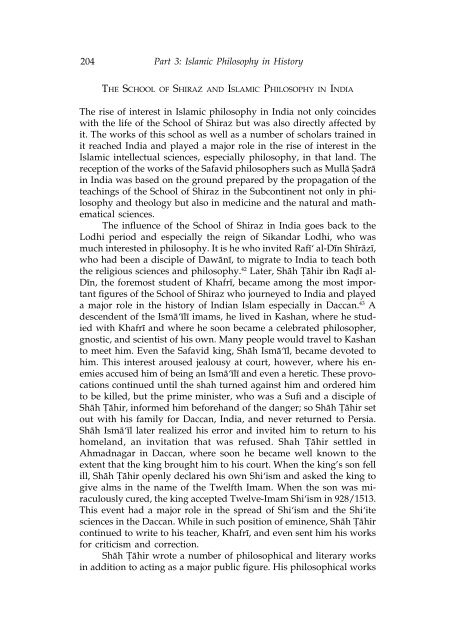Islamic Philosophy from Its Origin to the Present: Philosophy in the ...
Islamic Philosophy from Its Origin to the Present: Philosophy in the ...
Islamic Philosophy from Its Origin to the Present: Philosophy in the ...
You also want an ePaper? Increase the reach of your titles
YUMPU automatically turns print PDFs into web optimized ePapers that Google loves.
204 Part 3: <strong>Islamic</strong> <strong>Philosophy</strong> <strong>in</strong> His<strong>to</strong>ry<br />
THE SCHOOL OF SHIRAZ AND ISLAMIC PHILOSOPHY IN INDIA<br />
The rise of <strong>in</strong>terest <strong>in</strong> <strong>Islamic</strong> philosophy <strong>in</strong> India not only co<strong>in</strong>cides<br />
with <strong>the</strong> life of <strong>the</strong> School of Shiraz but was also directly affected by<br />
it. The works of this school as well as a number of scholars tra<strong>in</strong>ed <strong>in</strong><br />
it reached India and played a major role <strong>in</strong> <strong>the</strong> rise of <strong>in</strong>terest <strong>in</strong> <strong>the</strong><br />
<strong>Islamic</strong> <strong>in</strong>tellectual sciences, especially philosophy, <strong>in</strong> that land. The<br />
reception of <strong>the</strong> works of <strong>the</strong> Safavid philosophers such as Mullå |adrå<br />
<strong>in</strong> India was based on <strong>the</strong> ground prepared by <strong>the</strong> propagation of <strong>the</strong><br />
teach<strong>in</strong>gs of <strong>the</strong> School of Shiraz <strong>in</strong> <strong>the</strong> Subcont<strong>in</strong>ent not only <strong>in</strong> philosophy<br />
and <strong>the</strong>ology but also <strong>in</strong> medic<strong>in</strong>e and <strong>the</strong> natural and ma<strong>the</strong>matical<br />
sciences.<br />
The <strong>in</strong>fluence of <strong>the</strong> School of Shiraz <strong>in</strong> India goes back <strong>to</strong> <strong>the</strong><br />
Lodhi period and especially <strong>the</strong> reign of Sikandar Lodhi, who was<br />
much <strong>in</strong>terested <strong>in</strong> philosophy. It is he who <strong>in</strong>vited Raf¥‘ al-D¥n Sh¥råz¥,<br />
who had been a disciple of Dawån¥, <strong>to</strong> migrate <strong>to</strong> India <strong>to</strong> teach both<br />
<strong>the</strong> religious sciences and philosophy. 42 Later, Shåh appleåhir ibn Ra∂¥ al-<br />
D¥n, <strong>the</strong> foremost student of Khafr¥, became among <strong>the</strong> most important<br />
figures of <strong>the</strong> School of Shiraz who journeyed <strong>to</strong> India and played<br />
a major role <strong>in</strong> <strong>the</strong> his<strong>to</strong>ry of Indian Islam especially <strong>in</strong> Daccan. 43 A<br />
descendent of <strong>the</strong> Ismå‘¥l¥ imams, he lived <strong>in</strong> Kashan, where he studied<br />
with Khafr¥ and where he soon became a celebrated philosopher,<br />
gnostic, and scientist of his own. Many people would travel <strong>to</strong> Kashan<br />
<strong>to</strong> meet him. Even <strong>the</strong> Safavid k<strong>in</strong>g, Shåh Ismå‘¥l, became devoted <strong>to</strong><br />
him. This <strong>in</strong>terest aroused jealousy at court, however, where his enemies<br />
accused him of be<strong>in</strong>g an Ismå‘¥l¥ and even a heretic. These provocations<br />
cont<strong>in</strong>ued until <strong>the</strong> shah turned aga<strong>in</strong>st him and ordered him<br />
<strong>to</strong> be killed, but <strong>the</strong> prime m<strong>in</strong>ister, who was a Sufi and a disciple of<br />
Shåh appleåhir, <strong>in</strong>formed him beforehand of <strong>the</strong> danger; so Shåh appleåhir set<br />
out with his family for Daccan, India, and never returned <strong>to</strong> Persia.<br />
Shåh Ismå‘¥l later realized his error and <strong>in</strong>vited him <strong>to</strong> return <strong>to</strong> his<br />
homeland, an <strong>in</strong>vitation that was refused. Shah appleåhir settled <strong>in</strong><br />
Ahmadnagar <strong>in</strong> Daccan, where soon he became well known <strong>to</strong> <strong>the</strong><br />
extent that <strong>the</strong> k<strong>in</strong>g brought him <strong>to</strong> his court. When <strong>the</strong> k<strong>in</strong>g’s son fell<br />
ill, Shåh appleåhir openly declared his own Shi‘ism and asked <strong>the</strong> k<strong>in</strong>g <strong>to</strong><br />
give alms <strong>in</strong> <strong>the</strong> name of <strong>the</strong> Twelfth Imam. When <strong>the</strong> son was miraculously<br />
cured, <strong>the</strong> k<strong>in</strong>g accepted Twelve-Imam Shi‘ism <strong>in</strong> 928/1513.<br />
This event had a major role <strong>in</strong> <strong>the</strong> spread of Shi‘ism and <strong>the</strong> Shi‘ite<br />
sciences <strong>in</strong> <strong>the</strong> Daccan. While <strong>in</strong> such position of em<strong>in</strong>ence, Shåh appleåhir<br />
cont<strong>in</strong>ued <strong>to</strong> write <strong>to</strong> his teacher, Khafr¥, and even sent him his works<br />
for criticism and correction.<br />
Shåh appleåhir wrote a number of philosophical and literary works<br />
<strong>in</strong> addition <strong>to</strong> act<strong>in</strong>g as a major public figure. His philosophical works

















